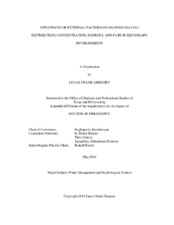| dc.contributor.advisor | Karthikeyan, Raghupathy | |
| dc.creator | Gregory, Lucas F | |
| dc.date.accessioned | 2016-07-08T15:14:31Z | |
| dc.date.available | 2018-05-01T05:49:28Z | |
| dc.date.created | 2016-05 | |
| dc.date.issued | 2016-04-26 | |
| dc.date.submitted | May 2016 | |
| dc.identifier.uri | https://hdl.handle.net/1969.1/157032 | |
| dc.description.abstract | E. coli contamination in surface waters is a universal issue that signifies increased risks to human health. Understanding E. coli fate, transport, sources, and distribution in watersheds is critical for reducing these risks. This study assessed E. coli fate in simulated mesocosms constructed using unaltered creek water and sediments with variable nutrient and flow treatments. E. coli concentrations in soil and runoff from small upland watersheds were used to assess transport and distribution while bacterial source tracking determined its sources.
Nutrient amendments and flow rate changes did not significantly alter E. coli fate in water or sediments but produced visible differences in some scenarios. Nutrient amendments representing irrigation runoff and wastewater spills did not produce discernable E. coli decay rate changes in water but marginally decreased observed decay rates in sediments. Alternatively, nutrient amendments affected heterotrophic bacteria decay and growth in water and sediments. Median heterotrophic bacteria decay and growth constant slopes were not significantly different between treatments and control, but were significantly different than median E. coli constant slopes during the initial growth phase suggesting that they outcompeted E. coli for available nutrient resources. E. coli concentrations were modeled with measured water quality parameters demonstrating that they could be predicted from independent variables including turbidity, specific conductivity, nitrate, ammonia, and orthophosphorus.
Watershed land use and cover significantly affected runoff and soil E. coli concentrations, runoff E. coli loads, and sediment concentrations and loads but not runoff volume. Within land uses, soil E. coli loads were significantly less than runoff E. coli loads suggesting that fecal deposition dominates loading in runoff. Wildlife contributed most runoff and soil E. coli, but livestock, humans and pets were also identified E. coli source contributors. Significant E. coli source composition differences were identified between watersheds in runoff but not soils. Grassed watersheds exhibited significant source composition differences between soil and runoff but this was not observed in cropland. | en |
| dc.format.mimetype | application/pdf | |
| dc.language.iso | en | |
| dc.subject | E. coli | en |
| dc.subject | Fate | en |
| dc.subject | Growth | en |
| dc.subject | Persistence | en |
| dc.title | Influences of External Factors on Escherichia Coli Distribution, Concentration, Sources, and Fate in Secondary Environments | en |
| dc.type | Thesis | en |
| thesis.degree.department | Biological and Agricultural Engineering | en |
| thesis.degree.discipline | Water Management and Hydrological Science | en |
| thesis.degree.grantor | Texas A & M University | en |
| thesis.degree.name | Doctor of Philosophy | en |
| thesis.degree.level | Doctoral | en |
| dc.contributor.committeeMember | Harmel, R Daren | |
| dc.contributor.committeeMember | Gentry, Terry | |
| dc.contributor.committeeMember | Aitkenhead-Peterson, Jacqueline | |
| dc.type.material | text | en |
| dc.date.updated | 2016-07-08T15:14:31Z | |
| local.embargo.terms | 2018-05-01 | |
| local.etdauthor.orcid | 0000-0002-1943-666X | |


